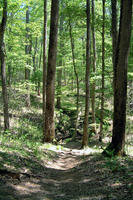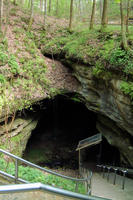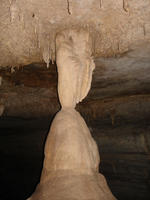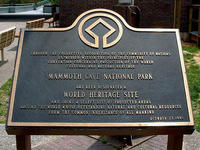You are in: North America -> United States of America -> Mammoth Cave Nationa... , and traditional search or Image Gallery will yield results of this site only
Mammoth Cave National Park
| Site number: | 150 |
|
| Type of site: | Natural | |
| Date: | - | |
| Date of Inscription: | 1981 | |
| Location: | North America, USA, Counties of Barren, Edmonson, and Hart in the State of Kentucky | |
Up to 75 images are shown here. Click on each for more details or on Image Gallery for more images.
| Description: | The state of Kentucky’s Mammoth Cave National Park holds the world's principal natural cave and underground passageway system – a distinguishing illustration of limestone formations. A diverse flora and fauna, among them numerous endangered species, reside in the park and its underground network of over 560 surveyed km of passageways. --WHMNet paraphrase from the description at WHC Site, where additional information is available. | |
| Mammoth Cave National Park is a U.S. National Park in central Kentucky, encompassing portions of Mammoth Cave, the most elongated cave system known in the world. The official name of the system is the Mammoth Cave System for the ridge under which the cave has formed. The park was established as a national park on July 1, 1941. It became a World Heritage Site on October 27, 1981, and an international Biosphere Reserve on September 26, 1990. The park's 52,830 acres (214 km²) are located in Edmonson County, Kentucky, with small areas extending eastward into Hart County and Barren County. It is centered around the Green River, with a tributary, the Nolin River, feeding into the Green just inside the park. The Green River is dammed near the western boundary of the park, so that the river only flows freely for a small section in the eastern part of the park. Mammoth Cave developed in thick Mississippian-aged limestone strata capped by a layer of sandstone, making the system remarkably stable. It is known to include more than 367 miles (591 kilometers) of passageway; new discoveries and connections add several miles to this figure each year. The upper sandstone member is known as the Big Clifty Sandstone: thin, sparse layers of limestone interspersed within the sandstones give rise to an epikarstic zone, in which tiny conduits (cave passages too small to enter) are dissolved. The epikarstic zone concentrates local flows of runoff into high-elevation springs which emerge at the edges of ridges. The resurgent water from these springs typically flows briefly on the surface before sinking underground again at elevation of the contact between the sandstone caprock and the underlying massive limestones. It is in these underlying massive limestone layers that the human-explorable caves of the region are developed. The limestone layers of the stratigraphic column beneath the Big Clifty, in increasing order of depth below the ridgetops, are the Girkin Formation, the Ste. Genevieve Limestone, and the St. Louis Limestone. For example, the large Main Cave passage seen on the Historic Tour is located at the bottom of the Girkin and the top of the St. Genevieve. Each of the primary layers of limestone are divided further into named units and subunits. One area of cave research involves correlating the stratigraphy with the cave survey produced by explorers. This makes it possible to produce three dimensional approximate maps of the contours of the various layer boundaries without the necessity for boring test wells and extracting core samples. The upper sandstone caprock is relatively hard for water to penetrate: the exceptions are where vertical cracks occur. This protective role means that many of the older, upper passages of the cave system are very dry, with no stalactites, stalagmites, or other formations which require flowing or dripping water to develop. --Wikipedia. Text is available under the Creative Commons Attribution-ShareAlike License. | ||
| Source: | http://whc.unesco.org/en/list/150 | |
| Reference: | 1. UNESCO World Heritage Center, Site Page. | |


























